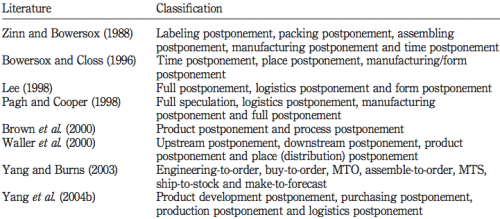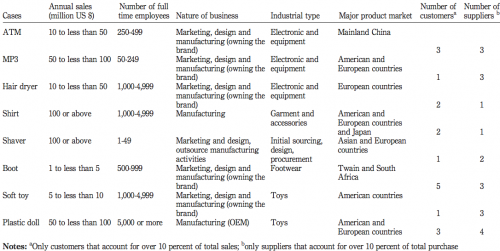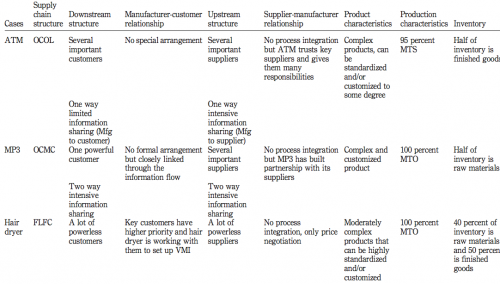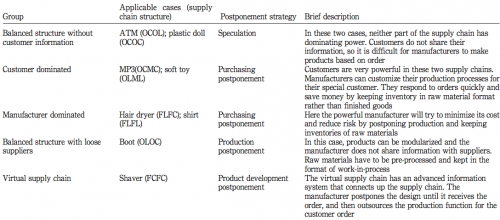The Postponement Strategy from a Supply Chain Perspective
If you think about it. Postponement is one of the more involving strategies available in supply chain management. At least from a design perspective, postponement requires changes to the value-generation process, which may comprise several echelons within the supply chain.
The paper I review today analyzed the implementation of postponement strategies in China and suggests factors to help with the decision which kind of postponement to select.
Types of postponement and its determinants
Figure 1 shows a summary of different types of postponement strategies, found in literature.
It can be defined “as a strategy that changes the differentiation of goods (form, identity and inventory location) to as late a time as possible.”
However:
Today researchers view postponement differently. Van Hoek (2001) views it as an organizational concept whereby some of the activities in the supply chain are not performed until customer orders are received.
The complement of postponement is speculation, “which means changing form and moving goods to inventories as early as possible to reduce the cost of supply chain.”
Figure 1: Different Postponement Strategies (Yeung et al., 2007)
Several factors affect the decision on which type of strategy to use. Other researchers already found the following determinants (beside others):
- technology and process characteristics (feasible to decouple primary and postponed operations, limited complexity of customizing operations, modular product designs, and sourcing from multiple locations);
- product characteristics (high commonality of modules, specific formulation of products, specific peripherals, high value density of products and product cube and/or weight increases through customization); and
- market characteristics (short product life cycle, high sales fluctuations, short and reliable lead times, price competition and varied markets and customers).
Method
Beside the literature review, of which some of the results are summarized above, the authors use a grounded theory approach to come to their conclusions.
This method comprises several semi-structured interviews with senior executives. The sample companies were taken from the Pearl River Delta (PRD) a region within the Guangdong province bordering Hong Kong.
Overall the interviews with eight companies were used for the grounded theory. The characteristics of the sample companies are presented in figure 2
Figure 2: Sample Companies and their Supply Chains (Yeung et al., 2007)
Cross-case analysis
In figure 3 the results of three (of eight) companies are compared.
Figure 3: Cross-Case Comparison (extract; Yeung et al., 2007)
The supply chain structure is characterized by a four letter acronym (second column in figure 3):
The first two letters refer to the supply side the second pair to the demand side.
Of those pairs the first letter (O/F) refers to the market type: *o*ligarch or *f*ree-market.
And the second letter (C/L) refers to the closeness of the actors: *c*lose or *l*oose.
Results
From these results the authors draw the following propositions:
P1. When a supply chain has a balanced structure, it should use speculation or production postponement.
In the balanced supply chain structure, no single actor is significantly more powerful than any other actor. In order not be “locked” in by a specific partner and losing business opportunities and/or bargaining power, a company will not tailor their processes for a specific partner. However, the key concept of postponement is to produce based on actual orders instead of forecasts, and this requires a close relationship between partners.
P2. When the supply chain has an unbalanced structure, it should use purchasing postponement or product development postponement.
The unbalanced supply chain is characterized by a leading company who has more power than other companies in the supply chain. In order to improve efficiency and provide a high service level, the leading company often demands other companies to tailor their production process and share information. As such, it is easier to build close relationships in an unbalanced structure than it is in a balanced one. This makes high degree postponement possible and suitable.
Figure 4 shows the summary of the strategic implications.
Figure 4: Strategy Selection based on Supply Chain Structure and Information Sharing (Yeung et al., 2007)
Conclusion
First the ugly:
Key to a grounded theory approach in accordance with Strauss and Corbin (as the authors want to do) is the number of cases used. This number has to be determined by the so-called point of theoretical saturation. This means that the researcher only stops once the last case(s) did not produce any new insights. A typical number of interviews for a grounded theory would be between twenty and thirty.
In this case the authors set themselves an artificial limit of about 7 cases. This is actually often used in case-study research, which is another research methodology. But in case study research one usually taps on several other data sources to triangulate and validate the data.
To conclude, I really do not know what method the authors used. And therefore the validity of the study suffers.
Second the good:
Nonetheless figure 4 can be used as a guideline to select from different types of postponement strategies depending on the supply chain characteristics. It should just be used with a certain wariness.
Yeung, J. H. Y., Selen, W., Deming, Z., & Min, Z. (2007). Postponement strategy from a supply chain perspective: cases from China International Journal of Physical Distribution & Logistics Management, 37 (4), 331-356 DOI: 10.1108/09600030710752532












Add new comment